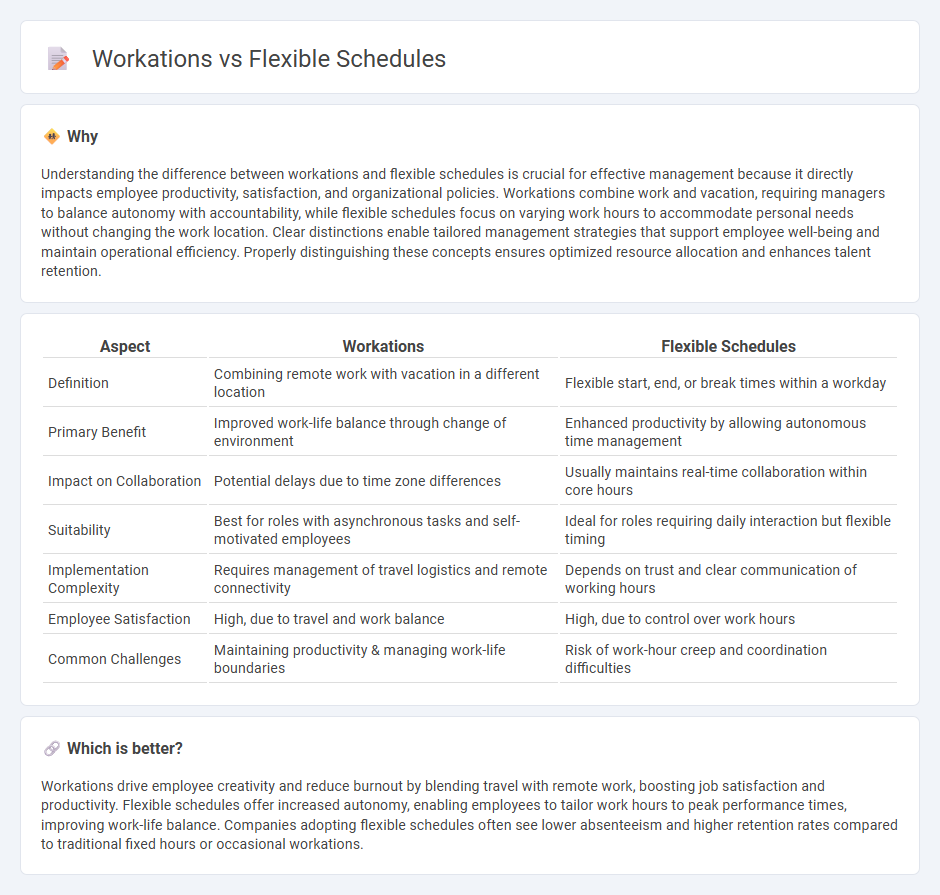
Workations combine work and travel, offering remote employees the chance to maintain productivity while exploring new environments, boosting creativity and job satisfaction. Flexible schedules allow workers to tailor their hours for better work-life balance, enhancing overall efficiency and reducing burnout. Explore the benefits and challenges of workations and flexible schedules to optimize your management strategy.
Why it is important
Understanding the difference between workations and flexible schedules is crucial for effective management because it directly impacts employee productivity, satisfaction, and organizational policies. Workations combine work and vacation, requiring managers to balance autonomy with accountability, while flexible schedules focus on varying work hours to accommodate personal needs without changing the work location. Clear distinctions enable tailored management strategies that support employee well-being and maintain operational efficiency. Properly distinguishing these concepts ensures optimized resource allocation and enhances talent retention.
Comparison Table
| Aspect | Workations | Flexible Schedules |
|---|---|---|
| Definition | Combining remote work with vacation in a different location | Flexible start, end, or break times within a workday |
| Primary Benefit | Improved work-life balance through change of environment | Enhanced productivity by allowing autonomous time management |
| Impact on Collaboration | Potential delays due to time zone differences | Usually maintains real-time collaboration within core hours |
| Suitability | Best for roles with asynchronous tasks and self-motivated employees | Ideal for roles requiring daily interaction but flexible timing |
| Implementation Complexity | Requires management of travel logistics and remote connectivity | Depends on trust and clear communication of working hours |
| Employee Satisfaction | High, due to travel and work balance | High, due to control over work hours |
| Common Challenges | Maintaining productivity & managing work-life boundaries | Risk of work-hour creep and coordination difficulties |
Which is better?
Workations drive employee creativity and reduce burnout by blending travel with remote work, boosting job satisfaction and productivity. Flexible schedules offer increased autonomy, enabling employees to tailor work hours to peak performance times, improving work-life balance. Companies adopting flexible schedules often see lower absenteeism and higher retention rates compared to traditional fixed hours or occasional workations.
Connection
Workations and flexible schedules are connected through their shared focus on enhancing employee productivity and work-life balance by allowing individuals to work from various locations and during preferred hours. Companies implementing these strategies often report increased job satisfaction, reduced burnout, and improved retention rates, as employees have greater control over their environment and time management. This synergy supports modern workforce trends emphasizing autonomy, digital connectivity, and well-being in management practices.
Key Terms
Remote Work
Flexible schedules empower remote workers to tailor their hours around peak productivity and personal commitments, enhancing work-life balance. Workations combine travel with remote work, offering creativity boosts but potential challenges in maintaining consistent productivity. Explore how adopting flexible schedules and workations can transform your remote work experience for greater efficiency and satisfaction.
Work-Life Balance
Flexible schedules empower employees to adjust their working hours for better alignment with personal commitments, enhancing overall work-life balance. Workations combine travel with work, offering a change of scenery that can boost creativity and reduce burnout. Discover how adopting these alternatives can transform your professional and personal life.
Productivity
Flexible schedules empower employees to tailor work hours to peak productivity periods, reducing burnout and enhancing overall efficiency. Workations blend remote work with travel, offering a change of scenery that can stimulate creativity but may introduce distractions impacting focus. Explore how balancing flexible schedules and workations can optimize workplace productivity for your team.
Source and External Links
8 types of flexible work schedules for the modern workforce - Flexible schedules allow employees to customize their start and end times, compress their workweek, or split shifts to match productivity patterns, often including options like compressed workweeks or flextime.
What is a Flex Schedule, Pros and Cons - Flex schedules enable employees to choose their working hours and days, supporting full-time, part-time, or remote work, and can include compressed workweeks for better work-life balance.
Flexible Shift Jobs @ Amazon Search Results - Flexible schedules at Amazon let employees pick shifts that fit their availability each week, receiving notifications for new shifts and building their schedule around personal commitments.
 dowidth.com
dowidth.com